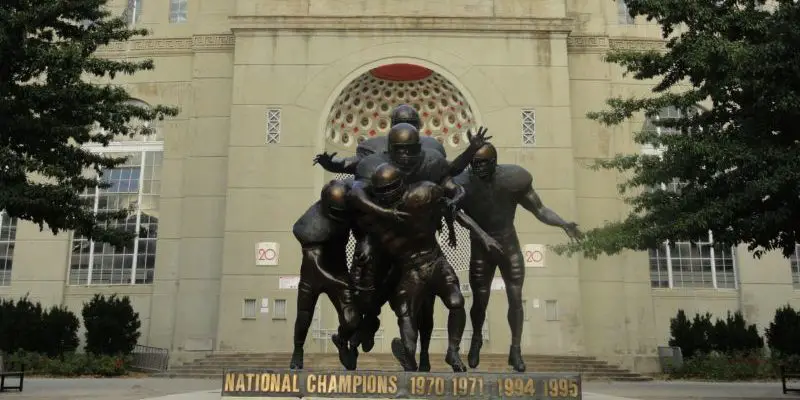I’m still flummoxed that the Cornhuskers ever hired Mike Riley. He seems likeable enough but, even as the winningest coach in Oregon State’s storied football history, one struggles to call him a “successful coach” by any meaningful measure. When the Cornhuskers needed an institutional change from Bo Pelini, whose worst season was 9-4, Mike Riley did not jump to mind; at least not to any in Oregon.
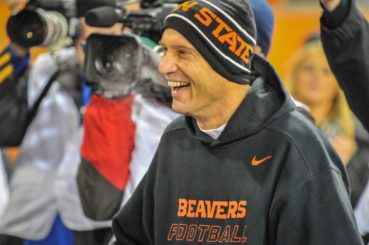
Mike Riley is likable fellow and had a great time in Corvallis.
On Sunday of course, you, the Readers, will know whether I was correct and Oregon outscored Nebraska in a modest shoot-out (my forecast 38-34 Oregon, but I’m hoping for something more like 38-27). If I’m wrong, the difficulties of publishing on Sunday when one becomes obsessed with Saturday’s game will be all too apparent, so I will plan ahead and hedge this opinion with a forked-tongue and invite you to read between the lines.
A week ago, I was convinced the 2016 Ducks would not stand a chance against the 2016 Cornhuskers. The season was all but over. It is, after all, Nebraska. Football royalty. Another 4-loss season was upon us. And, if calamity strikes, it could be Oregon’s first 5-loss season in a decade. But then I looked at the data from Riley’s maiden Cornhusker voyage, and it is as underwhelming as his data from Corvallis; more so because now it’s coming out of Blue-blood territory.

Beavers fans … not so much. It’s a well known fact that Beavers fans often drank whatever they could find, and heavily, to cope with Riley’s reign. And with Corvallis. Because it stinks. And not just metaphorically.
Granted, one season of data isn’t much to work with but Riley’s 6-7 2015 Cornhuskers smell like the paper mills followed him to Lincoln. His is not a complicated scheme and vanilla stats tell us well what we need to know.
For example, turn-overs are important. With the turnover advantage, Riley’s Huskers had a .667 win percentage at 4-2; when Riley lost the TO battle: 0-7. Also of note, Riley’s 2015 Huskers were 4-0 when they rushed for more than 200 yards.
Now, the pundits contrast that to Oregon’s woeful rush defense and smack their lips at the idea of Oregon ignominy. But what that really tells us it that Riley’s Huskers broke 200 yards rushing only four times the entire season. (Oregon did that 9 times in 2015, going 7-2.)
And outside of the 329 yards Riley’s Huskers booked on terra firma against UCLA in the venerable Foster Farms Bowl, they lodged 200+ yard rushing games against institutions that have been praised for their tough inside defense such as Minnesota and the respective Southern Mississippi and South Alabama.
In the other 9 games below 200 yards Riley went 2-7, with an impressive win over Rutgers and a head-scratcher over Michigan State, in which (you may recall) the Cornhusker receiver caught the winning TD play on Nebraska’s final possession just steps after he was out of bounds.
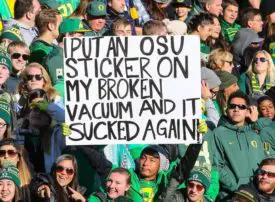
In fairness, OSU still sucks even without Riley.
Maybe on Sunday morning these facts will take on a different meaning, but the Ducks regularly give up 200+ yards on the ground and still win. That’s not necessarily a good thing, I know, but the 200-yard rushing threshold is somewhat irrelevant in Eugene.
When the 2015 Oregon defense gave up 200+ on the ground the team was 3-1: outside of Utah, the only loss that included a heavy ground attack, the 2015 Ducks gave up 200+ on the ground 3 other times and still beat the Beavers, the Cardinal and Sun Devils.
When Oregon lost the turnover battle they still eked out a .333 batting average going 1-2; with the turnover advantage: 8-0 (let’s not speak of the two stunning losses when TOs were a push). Bottom line: if Oregon wins turn-overs, they win. If Nebraska wins turn-overs, they might win.
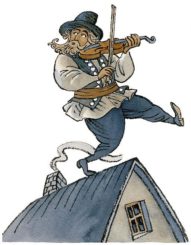
Sometimes tradition leads us right off the roof.
Every Ducks fan knows the traditional metrics that favor traditional teams, such as Nebraska, don’t always carry the same weight when Oregon comes to town. And if I look like a fool Sunday morning following a loss to Riley’s Huskers, then it truly will be a testament that the new Oregon is a far more traditional program than it was when Chip Kelly jumped off Mike Belotti’s shoulders to swing from the BCS chandelier onto the elite stage. If tending toward traditionalism trends away from that elitism, maybe, just maybe, tradition is not the touchstone for Oregon.
I don’t know any Ducks fan that thinks of the 2015 season as a success. But a 9-4 record – albeit 2nd in the Pac-12 North after beating the league champs, Stanford, is a pretty good ‘bad’. The only time Riley was better than 9-4 was in 2006 when his team played 14 games. (10-4: one way to beat 9-4.)
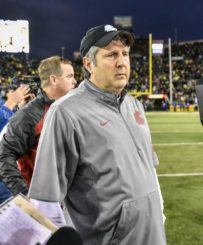
Just look at the state of Mike Leach.
Here’s the point: if you didn’t see the bad moon rising over Eugene when Ducks lost to Washington State, permit me to briefly revisit the lesson: getting blown out at home to Kyle Whittingham’s Utes - who at least were playing top-notch football at the time – was bad enough but losing to Mike Leach?
His Cougars have never played top notch football. If that doesn’t trigger a rebuilding period, I don’t know what would. (Oh, right. Giving up a 31-point lead on national television.) If Riley broke his 8-year losing streak against Oregon yesterday, it’s not rock bottom. His coaching record against the Pac-12, believe it or not, is 93-80. Leach’s is 21-31. Losing to Leach was rock bottom. And like all of Oregon’s woes last year, that likely wouldn’t have happened with a healthy Vernon Adams.

Irrespective of Saturday’s outcome, the Ducks have a lot of work to do to compete for the Pac-12 North.
And even with a win yesterday, the Ducks have at least 3 more adversaries that stand taller than Mike Riley: David Shaw, Whittingham, and Todd Graham.
While Dakota Prukop looks far more consistent, more stable and sturdier than Adams ever did, keeping him healthy, getting him rest when the Ducks have a serviceable lead and getting Justin Herbert meaningful reps, is going to be a critical factor in the stretch.
More puzzling than the Nebraska Athletic Director Shawn Eichorst’s choice of head coach is our own head coach’s decision to not only leave Prukop in when the Virginia game was in hand, but to have him run. Between the tackles.
As disappointing as a loss to Riley would be, it wouldn’t tell us anything new. Riley is a respectable coach, and Nebraska is a respectable program. I just cannot bring myself to put Leach or his Cougars on that list.
So even if, and that’s a big if, Riley somehow bested Oregon yesterday, meh. What is more troubling to me is the apparent retrenchment of the tactics that made Oregon an elite program despite the fact that the athletes still boast the same amazing skill sets.
During the first year of Mark Helfrich’s tenure, while in Charlottesville, Marcus Mariota sat out more than ½ of the 4th quarter against the Cavaliers, and the only way the offense could have avoided putting up 2 rushing TDs would have been for Jeff Lockie to start taking a knee with about 8:30 to go.
At home in 2016, Prukop stayed in for the stretch, yet the offense was entirely unproductive in the 4th. In 2013, Oregon lost the time-of-possession battle by 17 minutes and it couldn’t have mattered less: 16 possessions, 8 TDs and 1 FG. In 2016, time of possession increased by 7 minutes – meaning it was split almost 50-50 (approximately 28:30 to 31:30) – but only had 12 possessions, 6 TDs and 1 FG. In 2013 the Ducks kept a short field and moved fast putting up points, on average, about every 55 yards. Three years on, that metric jumps to 90 yards against a bottom-tier opponent.
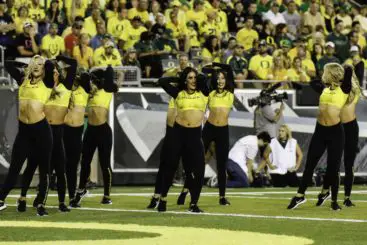
Oregon’s cheerleaders got more action in the 4th Quarter than Oregon’s offense.
What troubles me is that the offensive production against UVa, with the starter in the entire game, exacerbated last year’s trend: the Ducks came out strong with 155 yards in the first, peaked in the 2nd with 238, and fell off throughout the second half with 72 and 77 yards in the 3rd and 4th, respectively.
They scored 2/3 of the points and generated ¾ of the total game’s entire offensive production in the first half, and held onto the lead while the opponent’s production increased 200% in the second. This trend must end if Oregon is to remain in contention for the Pac-12 North. It’s great to build a strong lead, but the coaches have to hit the film room and reconfigure the half-time adjustments with which the Oregon-of-old stretched the lead and dominated opponents.
So, if our Ducks beat Riley, again, ho hum. However, if the Ducks continue to lose to middling FBS programs, the punditry about the decline of an elite program may be on point. And while the plan to avoid further decline is not yet apparent, so help me CENSORED we better not CENSORED lose to CENSORED Mike CENSORED Leach again!
Top photo credit: Wikimedia
Related Articles:
Oregon Enters Playoffs Better Off Than Last Year
Will The Coaching Carousel Kill Oregon's CFP Chances?
The Playoff Formula Hasn't Changed
Oregon Aims to Bury Dawgs, Punch Playoff Ticket in Rivalry Clash
Huskies Are the New Beavers, Stay In Your Lane Kiffin, and the Civil Apple Cup War
Oregon Football: The X-Factor Vs. Washington
Matt grew up in Oregon, graduated UO in 1998, and tried to impress a young lady (not from Oregon) by going to law a fancy law school on the East Coast. He did pretty well in law school but never saw the young lady again. Matt is now a lawyer in New York where he bores everyone around him with tales of how much better life can be in the Pacific NW usually carrying on about the biking, the coast, the salmon, the complete lack of humidity, Reubens from The Goose Hollow Inn, and Ducks football.
When Matt is not litigating high-stakes, important, commercial disputes for important people, arguing important points, or writing important things, he is likely either reading, on his bike, or (from late August through February) watching football. He lives with his family on North Shore of Long Island because the coast overlooking the Sound almost has a real shoreline but still can’t hold a candle to Oregon’s coast.

